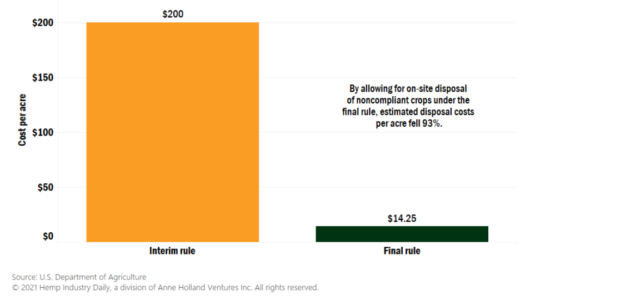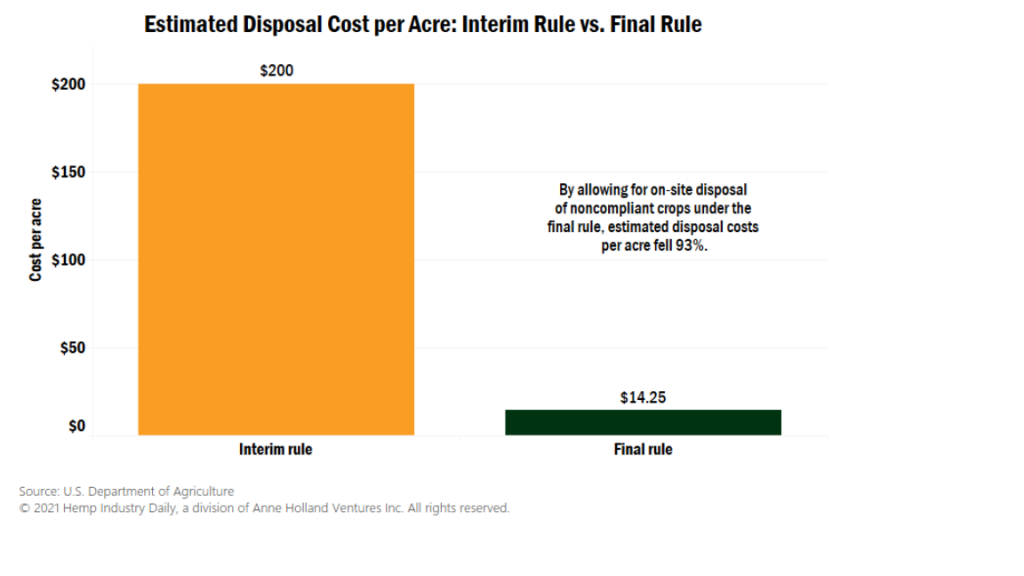Chart: Making sense of USDA’s new rules for disposing of hot hemp
FeaturedIndustrial Hemp NewsMarijuana Laws, Regulations, & Politics January 29, 2021 MJ Shareholders 0


(Editor’s note: This comes from Hemp Industry Daily‘s free updated USDA Final Hemp Rule report, available for download here.)
The mishmash of U.S. hemp rules is on its way out.
More than two years after Congress made hemp a legal agricultural commodity, farmers finally have one national set of rules for growing it — instead of a confusing, state-by-state patchwork of guidelines on how to grow and test low-THC cannabis plants.
One of the big changes in the national hemp rules from the U.S. Department of Agriculture concerns disposal and destruction of hot hemp, or plants that test higher than 0.3% THC content.
In its interim rules, the USDA required legal hemp farmers to treat any hot plants as illegal drugs. That meant farmers had to enlist law enforcement officers (or federal agents licensed to destroy Schedule 1 substances) to exterminate those plants at an off-farm location.
In traditional agriculture, unwanted plants are simply plowed under or thrown away. Plants that contain dangerous pathogens are commonly burned in the field to prevent the spread of disease.
In response to numerous complaints from farmers about the burden this rule created, the USDA’s final rules allow states, territories and tribes to permit “common on-farm practices for the disposal of noncompliant plants.”
Those practices could include:
- Plowing, tilling or disking hot hemp into the soil.
- Mulching, composting, chopping or bush–mowing plant material into green manure.
- Burning.
- Burying hot hemp by covering it with soil.
The USDA concluded that the change would “minimize, to the extent possible, the resource impact” to local regulators.
For hemp farmers, the USDA estimates big savings from its new disposal protocols for destroying hot hemp — from an average $200 per acre to $14.25 per acre. That’s a decrease of 93%.
“We are confident that any disposal options make the product unusable and therefore is not at risk for entering any streams of commerce,” federal regulators said.
States still must keep records of how their farmers dispose of the hot hemp and share the information with federal authorities within 30 days.
The new disposal protocols don’t apply to hemp material destroyed by a farmer because of:
- Poor plant health.
- Pests.
- Disease.
- Weather events.
- Removal of male or hermaphrodite plants as part of a cross-pollination–prevention plan.
In these cases, farmers remain free to use any disposal methods they prefer.
The new disposal protocols also do not apply to growers directly licensed by the USDA, rather than by a state, tribe or territory. USDA-licensed farmers must follow the complicated drug protocols of having law enforcement or DEA-registered agents destroy hot hemp off-site.
To download the full report on the final USDA hemp rules, click here.
MJ Shareholders
MJShareholders.com is the largest dedicated financial network and leading corporate communications firm serving the legal cannabis industry. Our network aims to connect public marijuana companies with these focused cannabis audiences across the US and Canada that are critical for growth: Short and long term cannabis investors Active funding sources Mainstream media Business leaders Cannabis consumers











No comments so far.
Be first to leave comment below.